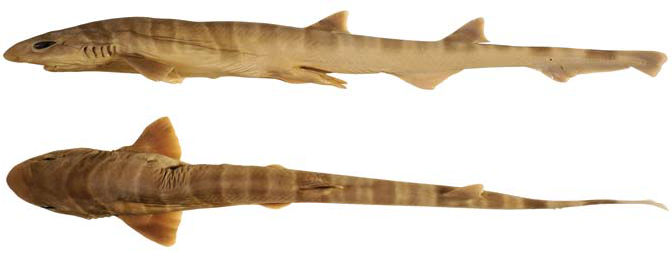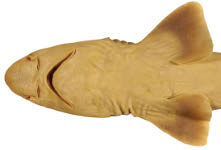Figaro striatus
Gledhill, Last & White, 2008
Northern sawtail shark
Classification: Elasmobranchii Carcharhiniformes Pentanchidae
Reference of the original description
Resurrection of the genus Figaro Whitley (Carcharhiniformes: Scyliorhinidae) with the description of a new species from northeastern Australia. CSIRO Marine and Atmospheric Research Paper, 22, 179–188
Resurrection of the genus Figaro Whitley (Carcharhiniformes: Scyliorhinidae) with the description of a new species from northeastern Australia. CSIRO Marine and Atmospheric Research Paper, 22, 179–188
Image of the original description

Lateral view of Figaro striatus sp. nov, paratype CSIRO H 1311–02 (adult male 381 mm TL), fresh. In: GLEDHILL, D.C. & Last, P.R. & White, W.T. (2008): Resurrection of the genus Figaro Whitley (Carcharhiniformes: Scyliorhinidae) with the description of a new species from northeastern Australia. CSIRO Marine and Atmospheric Research Paper, 22: 179-188

Lateral view of Figaro striatus sp. nov, paratype CSIRO H 1311–02 (adult male 381 mm TL), fresh. In: GLEDHILL, D.C. & Last, P.R. & White, W.T. (2008): Resurrection of the genus Figaro Whitley (Carcharhiniformes: Scyliorhinidae) with the description of a new species from northeastern Australia. CSIRO Marine and Atmospheric Research Paper, 22: 179-188
Types
Figaro striatus
Holotype: CSIRO: H 1312-01; Paratype: CSIRO: H 1313-02; CSIRO: H 1313-01; CSIRO: H 1312-05; CSIRO: H 1312-03; CSIRO: H 1312-02; CSIRO: H 1311-02; CSIRO: H 1310-01; CSIRO: H 1312-04; CSIRO: H 1311-01; CSIRO: H 1310-02;
Figaro striatus
Holotype: CSIRO: H 1312-01; Paratype: CSIRO: H 1313-02; CSIRO: H 1313-01; CSIRO: H 1312-05; CSIRO: H 1312-03; CSIRO: H 1312-02; CSIRO: H 1311-02; CSIRO: H 1310-01; CSIRO: H 1312-04; CSIRO: H 1311-01; CSIRO: H 1310-02;
Description :
Citation: Figaro striatus Gledhill, Last & White, 2008: In: Database of modern sharks, rays and chimaeras, www.shark-references.com, World Wide Web electronic publication, Version 01/2026
Please send your images of "Figaro striatus" to info@shark-references.com

Figaro striatus sp. nov, holotype CSIRO H 1312–01 (adult male, 421 mm TL), preserved: lateral view; dorsal view. In: GLEDHILL, D.C. & Last, P.R. & White, W.T. (2008): Resurrection of the genus Figaro Whitley (Carcharhiniformes: Scyliorhinidae) with the description of a new species from northeastern Australia. CSIRO Marine and Atmospheric Research Paper, 22: 179-188

Figaro striatus sp. nov, holotype CSIRO H 1312–01 (adult male, 421 mm TL), preserved: lateral view; dorsal view. In: GLEDHILL, D.C. & Last, P.R. & White, W.T. (2008): Resurrection of the genus Figaro Whitley (Carcharhiniformes: Scyliorhinidae) with the description of a new species from northeastern Australia. CSIRO Marine and Atmospheric Research Paper, 22: 179-188
Common names
 Northern sawtail shark
Northern sawtail shark
 Northern sawtail shark
Northern sawtail shark
Short Description
A very small species of catshark with the following characters: head in dorsoventral view narrowly parabolic, short 17.2-19.6% TL; small eye, its length 3.4-3.9% TL, 1.73-2.03 in snout, dorsolaterally located; well developed labial furrows , extending well beyond corners of mouth, lower furrow is slightly longer than the upper one; first dorsal fin is slightly smaller than the second one; small pelvic fins, slender, length 8.8-11.3% TL; posterior portion strongly directed posterodorsally (forming a small lobe, enveloping partly the proximo-lateral margin of clasper); strongly convex inner margin, forming a partial apron and connected to clasper dorsomedially near its base, soft tissue connecting insertions of pelvic fins is weak, not forming a prominent apron overlying ventral surface of tail; a much longer anal-fin base than second dorsal fin, base 9.9-10.9% TL, 2.4-6.0 times anal-caudal space; long caudal peduncle, anal-caudal space 1.6-4.2% TL; crest of enlarged denticles on anterior dorsal caudal-fin margin extending from about over origin of ventral caudal-fin lobe to almost mid-length of dorsal caudal-fin margin; crest of enlarged denticles originating at mid-point of caudal peduncle, extending to elevated part of ventral lobe; size at maturity for at about 38.0 cm TL; preserved color pale brown dorsally, with dark saddles and bars, lighter ventrally; pre-dorsally with about 4 larger saddles; saddles present below and between dorsal fins and extending onto caudal, these are rarely larger than eye diameter; larger saddles are pale edged, separated by narrower, less distinct bars; saddles rarely extending below the lateral midline; 35-38 monospondylous vertebrae; 85-93 precaudal; 140-149 in total [3344].
A very small species of catshark with the following characters: head in dorsoventral view narrowly parabolic, short 17.2-19.6% TL; small eye, its length 3.4-3.9% TL, 1.73-2.03 in snout, dorsolaterally located; well developed labial furrows , extending well beyond corners of mouth, lower furrow is slightly longer than the upper one; first dorsal fin is slightly smaller than the second one; small pelvic fins, slender, length 8.8-11.3% TL; posterior portion strongly directed posterodorsally (forming a small lobe, enveloping partly the proximo-lateral margin of clasper); strongly convex inner margin, forming a partial apron and connected to clasper dorsomedially near its base, soft tissue connecting insertions of pelvic fins is weak, not forming a prominent apron overlying ventral surface of tail; a much longer anal-fin base than second dorsal fin, base 9.9-10.9% TL, 2.4-6.0 times anal-caudal space; long caudal peduncle, anal-caudal space 1.6-4.2% TL; crest of enlarged denticles on anterior dorsal caudal-fin margin extending from about over origin of ventral caudal-fin lobe to almost mid-length of dorsal caudal-fin margin; crest of enlarged denticles originating at mid-point of caudal peduncle, extending to elevated part of ventral lobe; size at maturity for at about 38.0 cm TL; preserved color pale brown dorsally, with dark saddles and bars, lighter ventrally; pre-dorsally with about 4 larger saddles; saddles present below and between dorsal fins and extending onto caudal, these are rarely larger than eye diameter; larger saddles are pale edged, separated by narrower, less distinct bars; saddles rarely extending below the lateral midline; 35-38 monospondylous vertebrae; 85-93 precaudal; 140-149 in total [3344].
Remarks
shark-references Species-ID=2270;
shark-references Species-ID=2270;

















